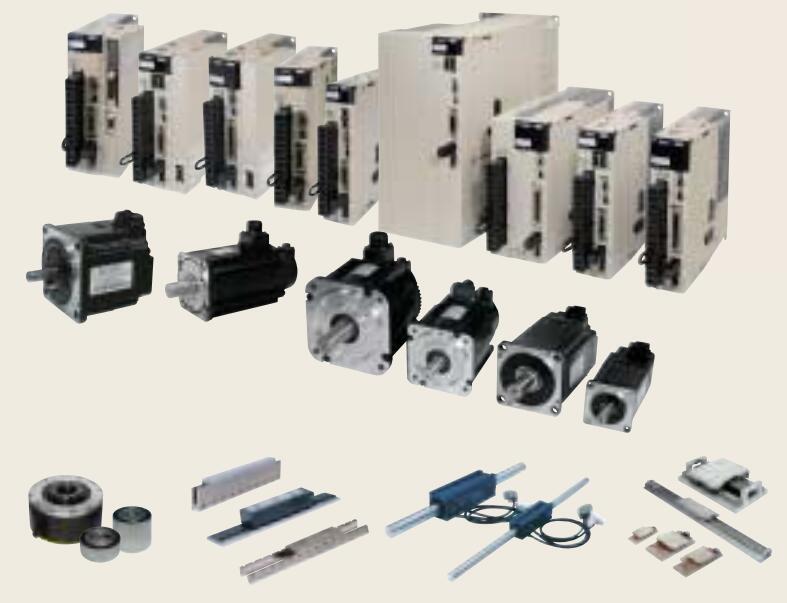Home
>> Products
>> Yaskawa
>> Servo driver / motor
>> SGDV type
>> SGMJV type motor
>> SGMJV-A5A3A6C Middle inertia rotary servo motor
SGMJV-A5A3A6C Middle inertia rotary servo motor
Yaskawa SGMJV-A5A3A6C Product information and technical parameters:
Brand: Yaskawa
Name: Middle inertia rotary servo motor
Model: SGMJV-A5A3A6C
Sigma -V series servo motor SGMJV.
Rated output: 0.05kw (50W).
Power supply voltage: AC200V.
Serial encoder: 20 bit absolute value (standard).
Design sequence: standard.
Shaft end: straight shaft with keyway, with screw (optional).
Optional: with hold brake (DC24V).
Medium inertia.
Instantaneous maximum torque (rating 350%).
Equipped with a high resolution serial encoder (13/20 bit).
Max speed up to 6000r/min.
Variety is complete (50 ~ 750W, with hold brake).
Use example:
Semiconductor manufacturing equipment,
Placement machine,
Punch printed circuit board,
Robot,
Handling machinery,
Food processing machinery.
Rating and specifications:
Rated time: continuous.
Vibration level: V15.
Insulation resistance: DC500V, 10M, or above.
Using ambient temperature: 0 ~ 40 degrees C.
Excitation mode: permanent magnet type.
Installation method: flange type.
Heat resistance grade: B.
Insulation withstand voltage: AC1500V 1 minutes.
Protection mode: fully enclosed self cooling type IP65 (except shaft through part).
The use of environmental humidity: 20 ~ 80% (not dew).
Connection mode: direct connection.
Rotation direction: clockwise direction (CCW) rotation at the load side under the direction of rotation.
Sigma -v series servo unit SGDV.
Maximum applicable motor capacity: 2kw.
Power supply voltage: three phase AC400V.
Design sequence: B type.
Interface: analog voltage, pulse sequence type (rotary servo motor).
Matching (hardware): paint.
Excellent mechanical properties, do the best in the master!
Easy and efficient work, is no longer a dream,
Sigma -v series servo drive, you can make your dreams come true SGMJV-A5A3A6C SGMJV-A5A3A6C
Sigma -v series is equipped with new free adjustment function,
Broke the common sense of the servo drive "can''t run smoothly without adjusting",
To achieve a pass that is to use.
A new type of advanced automatic tuning function Sigma -v series,
The installation time can be shortened, and the performance of the machine can be fully played SGMJV-A5A3A6C. Servo driver SGD7S.
Maximum applicable motor capacity: 1.0kW.
Voltage: three phase AC200V.
Interface: MECHATROLINK-II communication command type.
Design sequence: A.
Hardware purchase: rack installation specifications.
Performance excellence.
The performance and speed of the device can be improved.
Upgrade free adjustment function.
Without adjusting the operation, no vibration can be achieved SGMJV-A5A3A6C.
To ensure that the procedures and parameters of the previous product compatibility.
After replacement of the product, can easily improve the performance of the device.
Sigma -7 series has rich models and related products.
Customers can easily build the system.
From selection to maintenance, rich service content.
Especially when the servo system is in trouble,
Can immediately grasp the product information in the field.
It is helpful to the servo performance of ultra high speed and ultra precision control.
Maximize the performance of the device, to solve the problemHigh performance, use the best type of servo unit (high performance).
Maximum applicable motor capacity: 0.1kw.
Power supply voltage: three phase AC200V.
Design sequence: B.
Hardware specifications: paint.
Interface: MECHATROLINK-III communication command type (linear servo motor).
Function: no deviation standard.
High performance sigma shaped -V-EX series.
2 models of high performance seervo unit SGMJV-A5A3A6C.
EX001 (support M- III high speed communication): the communication cycle is the minimum value of 125 s, which makes the response of the instruction becomes faster, and the track accuracy and processing ability are improved. SGMJV-A5A3A6C.
EX002 (no deviation of the specification): greatly improve the command tracking performance, and further improve the accuracy of trajectory control.
Maximum applicable motor capacity: 2kw.
Power supply voltage: three phase AC400V.
Design sequence: B type.
Interface: analog voltage, pulse sequence type (rotary servo motor).
Matching (hardware): paint.
Excellent mechanical properties, do the best in the master!
Easy and efficient work, is no longer a dream,
Sigma -v series servo drive, you can make your dreams come true SGMJV-A5A3A6C SGMJV-A5A3A6C
Sigma -v series is equipped with new free adjustment function,
Broke the common sense of the servo drive "can''t run smoothly without adjusting",
To achieve a pass that is to use.
A new type of advanced automatic tuning function Sigma -v series,
The installation time can be shortened, and the performance of the machine can be fully played SGMJV-A5A3A6C. Servo driver SGD7S.
Maximum applicable motor capacity: 1.0kW.
Voltage: three phase AC200V.
Interface: MECHATROLINK-II communication command type.
Design sequence: A.
Hardware purchase: rack installation specifications.
Performance excellence.
The performance and speed of the device can be improved.
Upgrade free adjustment function.
Without adjusting the operation, no vibration can be achieved SGMJV-A5A3A6C.
To ensure that the procedures and parameters of the previous product compatibility.
After replacement of the product, can easily improve the performance of the device.
Sigma -7 series has rich models and related products.
Customers can easily build the system.
From selection to maintenance, rich service content.
Especially when the servo system is in trouble,
Can immediately grasp the product information in the field.
It is helpful to the servo performance of ultra high speed and ultra precision control.
Maximize the performance of the device, to solve the problemHigh performance, use the best type of servo unit (high performance).
Maximum applicable motor capacity: 0.1kw.
Power supply voltage: three phase AC200V.
Design sequence: B.
Hardware specifications: paint.
Interface: MECHATROLINK-III communication command type (linear servo motor).
Function: no deviation standard.
High performance sigma shaped -V-EX series.
2 models of high performance seervo unit SGMJV-A5A3A6C.
EX001 (support M- III high speed communication): the communication cycle is the minimum value of 125 s, which makes the response of the instruction becomes faster, and the track accuracy and processing ability are improved. SGMJV-A5A3A6C.
EX002 (no deviation of the specification): greatly improve the command tracking performance, and further improve the accuracy of trajectory control.
...More relevant models >>>>
 Last one: Yaskawa Middle inertia rotary servo motor SGMJV-08A3A61
Last one: Yaskawa Middle inertia rotary servo motor SGMJV-08A3A61 next one: Yaskawa Middle inertia rotary servo motor SGMJV-01A3A6C
next one: Yaskawa Middle inertia rotary servo motor SGMJV-01A3A6C
Related download

